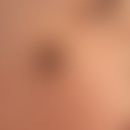Synonym(s)
DefinitionThis section has been translated automatically.
Nevi or malformations with eccrine glandular components are extremely rare. Their clinical morphology is as varied as it is uncharacteristic. Some nevi may have residual eccrine features, such as localized hyperhidrosis.
From the older literature, the following terms are grouped under this term:
- Hamartoma, eccrine angiomatous.
- Eccrine pilar angiomatous nevus
- Eccrine nevus (one variant is mucinous eccrine nevus/TemparkT et al 2013).
- Comedonal nevus of the palm of the hand
- Nevus, linear, eccrine with comedones
- Ostium nevus, porokeratotic-ecrine
ClinicThis section has been translated automatically.
Clinically very different, usually not very distinct clinical pictures, whose clinical morphology depends on the composition (angiomatous, hair follicle components, degree of differentiation) of the respective malformation (nevus) as well as on localisation and arrangement.
Differentiation is made:
- The nevus eccrinus as a purely eccrine hamartoma with local hyperhidrosis,
- The eccrine angiomatous hamartoma, a (also several; see case report) congenital, slowly growing, red to grey-blue, firm to very firm, painful nodule or a corresponding plaque with a stronger angiomatous component, which also shows hyperhidrosis. Mostly a sooey surface.
- Eccrine pilar angiomatous nevus (hamartoma)" combines eccrine, hair and vascular components (verrucous surface and hypertrichosis).
- The acrosyringeal nevus shows a linear plaque or it occurs with multiple papules, possibly in combination with epidermal dysplasia.
- The so-called eccrine porokeratotic ostium nevus (PEODDN) occurs as congenital, verrucous plaque on palms and soles. The focal hyperkeratoses correspond to cornoid lamellae. The sweat glands were normal in the published cases.
As a clinical form the PEODDN (Porokeratotic Eccrine Ostiumnaevus) belongs rather to the epidermal nevi.
You might also be interested in
HistologyThis section has been translated automatically.
TherapyThis section has been translated automatically.
Case report(s)This section has been translated automatically.
Eccrine angiomatous hamartoma
A 40-year-old patient noticed increasing, persistent, slightly reddened swellings on the lower legs in number and size for 12 months. At the same time massive lesional dysesthesia occurred. There were no extracutaneous symptoms and no trauma history.
Findings: On both sides of the ankles, both inside and outside, and to a lesser extent on the lower legs, 8 to palm-sized, considerably pressure dolent, blurredly limited, flach eleviated, doughy, inhomogeneous, livid-red plaques were found. Hyperhidrosis was present in sections.
Rennet: o.B.
Imaging examinations: o.B.
Histo: The histopathological examination showed a nodular hyperplasia of eccrine sweat glands and their excretory ducts in the reticular dermis, surrounded by mucin and ectatically dilated vascular spaces and increased nerve fibre bundles.
Therapy: At first an attempt of therapy with Botox-Infiltrationen was made (altogether 90 I.U in 2 sessions). Thereby temporary pain relief. Lymph drainage was without success. Finally, a großflächige subtotal excision of disease areas with plastic cover was performed in two sessions with split skin TX (defect area on the right 20×8 cm and two areas on the left medial 20×12 cm and lateral 17×12 cm). After healing, the patient showed significant improvement.
LiteratureThis section has been translated automatically.
- Bertacchini M et al (1991) Eccrine angiomatous nevus. Dermatologist 42: 631-633
- Laeng RH (2001) Late-onset eccrine angiomatous hamartoma: clinical, histological and imaging findings. Dermatology 203: 70-74
- Martinelli PT (2003) Eccrine angiomatous hamartoma: a case report and review of the literature. Cutis 71: 449-455
- Nakatsui TC (1999) Eccrine angiomatous hamartoma: report of a case and literature review. J Am Acad Dermatol 41: 109-111.
- Pelle MT (2002) Eccrine angiomatous hamartoma. J Am Acad Dermatol 47: 429-435.
- Romer JC et al (1994) Mucinosis eccrine nevus. Cutis 53: 259-261
- Sulica RL et al (1994) Eccrine angiomatous hamartoma (nevus): Immunohistochemical findings and review of literature. J cutan Pathol 21: 71-75
- Tempark T et al (2013) Mucinous eccrine naevus: case report and review of the literature. Clin Exp Dermatol 38:1-4.
- Tsuji T, Sawada H (1999) Eccrine angiomatous hamartoma with verrucous features. Br J Dermatol 141: 167-169.
- Velasco JA et al (1988) Eccrine-pilar angiomatous nevus. Dermatologica 177: 317-322
Incoming links (16)
Acrosyringeal nevus; Comedon nevus of the palms; Eccrine angiomatous hamartoma; Eccrine pilar angiomatous nevus; Eccrine pilar angiomatous nevus; Epidermal nevus organoid; Hamartoma eccrines; hamartoma of the skin; Naevus seborrhoicus et sudoriferus; Nevus eccrinus; ... Show allOutgoing links (4)
Adnexal tumors with eccrine differentiation; Eccrine angiomatous hamartoma; Hamartoma eccrines; Porokeratotic eccrine ostiumnaevus;Disclaimer
Please ask your physician for a reliable diagnosis. This website is only meant as a reference.





